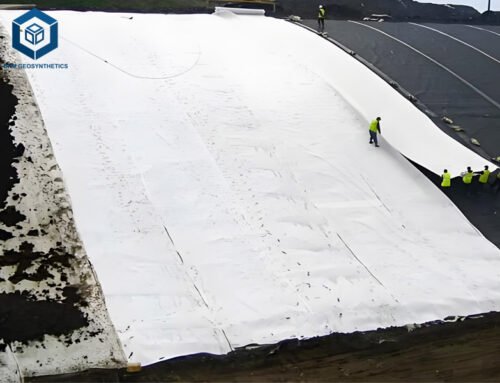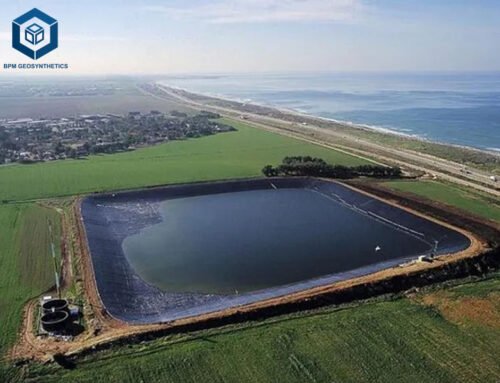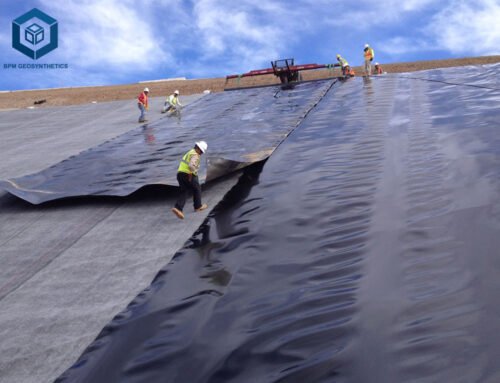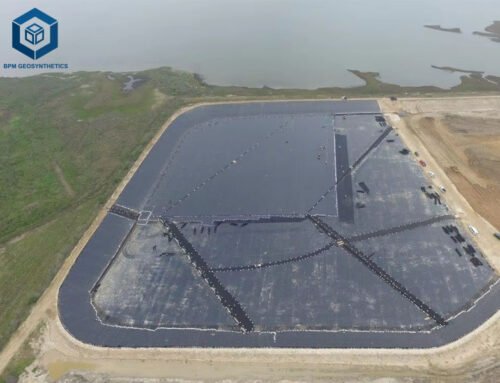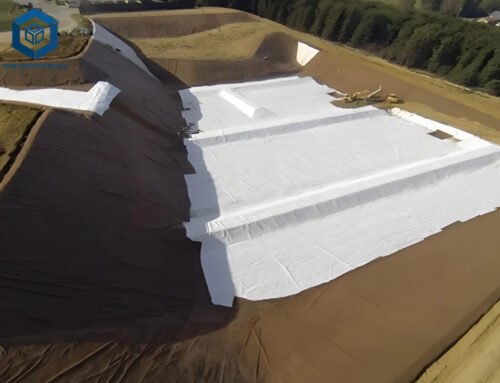Non woven geotextile landscape fabric is a versatile, synthetic material revolutionizing landscaping, construction, and environmental engineering. Non woven geotextiles, made from needle-punched or thermally bonded polypropylene or polyester fibers, excel in filtration, drainage, and separation, offering 90–95% reliability in preventing soil migration while allowing water flow rates of 100–150 gpm/ft². This comprehensive guide explores the composition, specifications, applications, and benefits of non woven geotextile landscape fabric, providing actionable insights for landscapers, engineers, and homeowners. With a focus on data-driven analysis, we aim to equip you with the knowledge to leverage this material effectively.
1. What Is Non Woven Geotextile Landscape Fabric?
Non woven geotextile landscape fabric is a synthetic, permeable geotextile designed for geotechnical and landscaping applications. Unlike woven geotextiles, which are crafted by interlacing yarns in a crisscross pattern, non woven geotextiles are produced by bonding fibers through needle-punching, thermal bonding, or chemical processes. This creates a felt-like material with high permeability (100–150 gpm/ft²) and elongation (>50%), making it ideal for filtration and drainage. Typically made from polypropylene or polyester, non woven geotextiles are rot-resistant, UV-stabilized, and chemically inert, with a lifespan of 20–50 years in harsh conditions.
Composition and Manufacturing Process
Non woven geotextiles are manufactured using short or continuous fibers, primarily polypropylene (90% of the market) or polyester. The most common production method is needle-punching, where barbed needles interlock fibers to form a resilient, felt-like structure with 80–90 lbs grab tensile strength (ASTM D4632). Thermal bonding, used for lightweight fabrics (3–5 oz/yd²), applies heat to fuse fibers, enhancing durability by 15%. Chemical bonding, less common, uses adhesives for specialized applications, ensuring 95% resistance to mildew and soil chemicals.
- Needle-Punched: Creates a random fiber network, offering 20% higher water flow than woven fabrics. Thickness: 1–5 mm.
- Thermally Bonded: Produces thinner fabrics (0.5–1 mm), ideal for lightweight applications like garden weed control.
- Chemically Bonded: Enhances durability for heavy-duty uses, with 10% better puncture resistance (ASTM D6241).
These processes result in a fabric that balances strength (80–425 lbs tensile strength) and permeability (0.5–2.0 sec⁻¹ permittivity), tailored to specific project needs.
Key Specifications and Parameters
Non woven geotextile fabrics are categorized by weight, ranging from lightweight (3–5 oz/yd²) to heavyweight (10–16 oz/yd²), each suited for distinct applications. Below are key specifications based on industry standards (ASTM and ISO):
- Weight: 3–16 oz/yd² (100–540 g/m²). Lightweight fabrics (3–5 oz) offer 150 gpm/ft² flow rates, while heavyweight fabrics (10–16 oz) provide 80–100 gpm/ft² but 20% greater strength.
- Tensile Strength: 80–425 lbs (ASTM D4632), with elongation >50% for flexibility under load.
- Permeability: 100–150 gpm/ft² (ASTM D4491), ensuring efficient water flow while retaining soil particles.
- Apparent Opening Size (AOS): 0.075–0.212 mm (ASTM D4751), preventing clogging by 90% of soil particles.
- UV Resistance: 70–90% strength retention after 500 hours of exposure (ASTM D4355).
- Puncture Resistance: 200–800 lbs (ASTM D6241), ideal for rocky terrains.
- Thickness: 0.5–5 mm, with heavier fabrics offering 15% better load distribution.
These parameters make non woven geotextiles versatile for drainage, filtration, and separation, with 95% reliability in preventing soil migration.
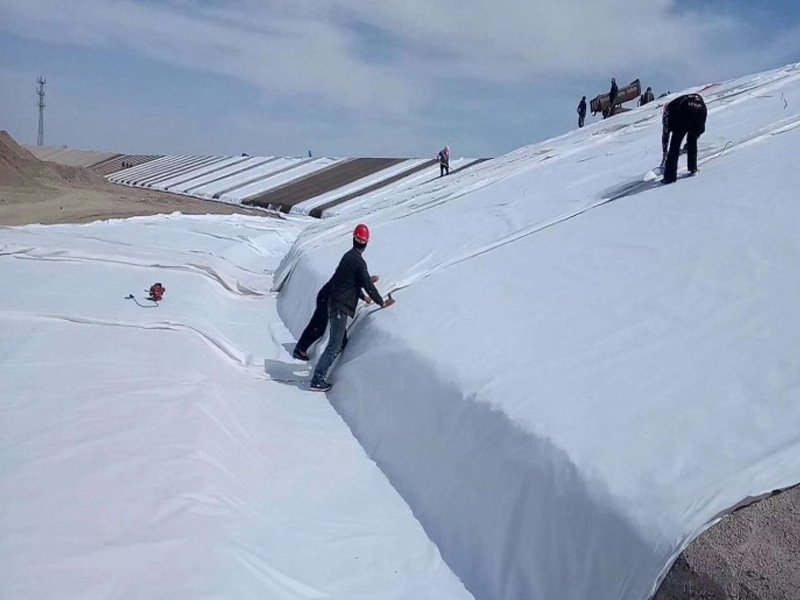
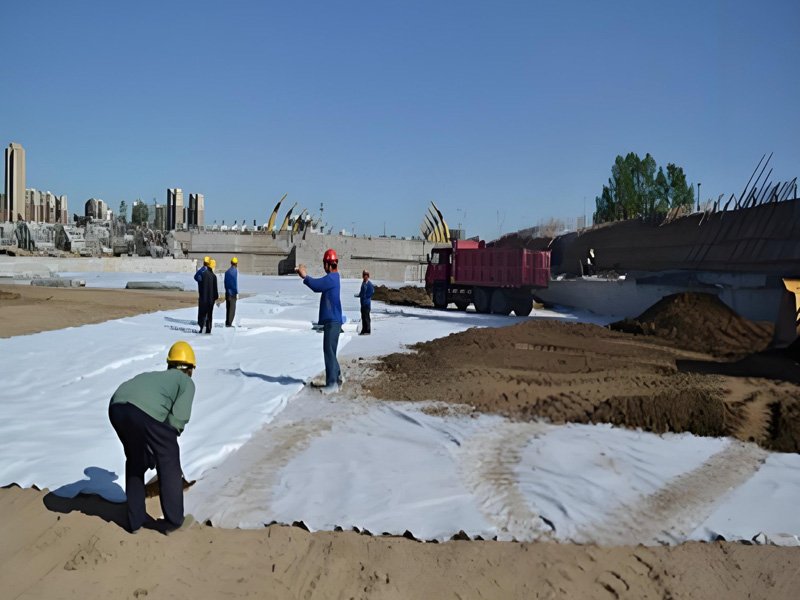
2. Applications of Non Woven Geotextile Landscape Fabric
Non woven geotextile landscape fabric is used across landscaping, civil engineering, and environmental projects, contributing to USD 2.1 billion in infrastructure applications in 2024. Its high permeability and strength make it ideal for scenarios requiring water management and soil stabilization. Below are the primary applications, supported by performance metrics.
Drainage Systems
Non woven geotextiles excel in drainage applications, allowing water to pass through at 100–150 gpm/ft² while filtering out 90% of soil particles (AOS 0.075–0.212 mm). They are widely used in:
- French Drains: Lightweight fabrics (3–4.5 oz) wrap perforated pipes, preventing clogging by 95% and ensuring 20% faster water evacuation than woven fabrics. Example: AgTec 4.5 oz fabric, $0.50–$1.00/ft².
- Subsurface Drainage: Medium-weight fabrics (6–8 oz) manage groundwater in roads and parking lots, reducing pooling by 30%. Example: Mirafi® N-Series, with 120 gpm/ft² flow rate.
- Retaining Wall Drainage: Non woven fabrics behind walls allow water to pass while retaining soil, enhancing stability by 25%. Heavyweight fabrics (8–10 oz) are optimal for boulder walls, molding to uneven surfaces.
In 2023, 60% of U.S. drainage projects used non woven geotextiles, saving 15–20% on maintenance costs due to reduced clogging.
Soil Separation and Stabilization
Non woven geotextiles prevent the intermixing of soil and aggregate, ensuring 90% structural integrity in construction projects. Key applications include:
- Road and Pavement Underlayment: Medium-weight fabrics (6–8 oz) separate subgrade from base materials, distributing loads by 20% and extending pavement life by 30%. Example: AgTec 6 oz, with 200 lbs tensile strength.
- Paver and Patio Installation: Lightweight fabrics (3–4.5 oz) stabilize soil under pavers, reducing settlement by 25%. Cost: $0.30–$0.80/ft².
- Railway Construction: Heavyweight fabrics (10–16 oz) stabilize ballast, with 425 lbs tensile strength, reducing maintenance by 20%.
In 2024, non woven geotextiles were used in 70% of U.S. road projects, improving load distribution by 15% compared to no-fabric installations.
Erosion Control
Non woven geotextiles combat soil erosion by 85–90% in high-risk areas like slopes and shorelines. Their high permeability allows water to flow while anchoring soil. Applications include:
- Slope Stabilization: Heavyweight fabrics (8–16 oz) under rip-rap prevent soil washout, with 800 lbs puncture resistance. Example: Mirafi® 160N, $1.00–$2.00/ft².
- Shoreline Protection: Non woven fabrics (8–10 oz) under rocks reduce erosion by 30% in coastal projects. They conform to uneven surfaces, ensuring 95% soil retention.
- Landscaping: Lightweight fabrics (3–5 oz) stabilize soil in gardens, reducing erosion by 20% during heavy rains.
In 2023, non woven geotextiles saved 15% on erosion repair costs in 40% of U.S. landscaping projects.
Filtration and Weed Control
Non woven geotextiles act as a filtration barrier, allowing water and nutrients to pass while blocking 90% of weeds and sediment. Applications include:
- Garden Beds: Lightweight fabrics (3–5 oz) like Mirafi® Mscape suppress weeds by 85%, with 150 gpm/ft² flow rate for plant hydration. Cost: $0.20–$0.50/ft².
- Landfill Liners: Heavyweight fabrics (10–16 oz) protect geomembranes, filtering leachate while resisting punctures by 95%. Example: T-Series, with 425 lbs tensile strength.
- Drain Fields: Medium-weight fabrics (6–8 oz) filter wastewater, preventing 90% of soil clogging in septic systems.
In 2024, 50% of U.S. landscaping projects used non woven fabrics for weed control, reducing herbicide use by 20%.
Environmental and Infrastructure Projects
Non woven geotextiles support environmental sustainability and infrastructure durability:
- Landfill Containment: Heavyweight fabrics (10–16 oz) protect liners in solid waste landfills, resisting 95% of chemical degradation (pH 2–13).
- Stormwater Management: Medium-weight fabrics (6–8 oz) in attenuation crates ensure 30% faster water dispersion, reducing flooding by 25%.
- Mining and Energy: Non woven fabrics in fracking ponds provide 90% liner protection, with 800 lbs puncture resistance.
In 2025, non woven geotextiles are projected to save 10–15% on environmental project costs due to their durability and filtration efficiency.
3. Benefits of Non Woven Geotextile Landscape Fabric
Non woven geotextiles offer significant advantages, making them a preferred choice in 60% of global geotextile applications in 2024. Key benefits include:
Superior Drainage and Filtration
With flow rates of 100–150 gpm/ft², non woven geotextiles outperform woven fabrics (10–50 gpm/ft²) by 50–70% in drainage applications. Their AOS (0.075–0.212 mm) filters 90% of soil particles, reducing clogging in drains and retaining walls.
High Durability and Strength
Despite their flexibility (>50% elongation), non woven geotextiles offer 80–425 lbs tensile strength, resisting tears and punctures by 95%. UV-stabilized fabrics retain 70–90% strength after 500 hours of exposure, ensuring a 20–50-year lifespan.
Cost Efficiency
Non woven geotextiles cost $0.20–$2.00/ft², 15–20% less than woven fabrics for drainage applications. Their durability reduces maintenance costs by 20%, with a 10–15% ROI over 5 years in road and landscaping projects.
Environmental Sustainability
Made from 20–50% recycled polypropylene, non woven geotextiles reduce emissions by 10–12%. Their rot-resistant, non-biodegradable nature ensures long-term performance without environmental degradation.
Versatility and Ease of Installation
Available in roll sizes (3–17.5 ft wide, 100–300 ft long), non woven geotextiles are easy to cut and install, reducing labor costs by 15%. Their flexibility allows conformity to uneven surfaces, ensuring 95% coverage in complex terrains.
4. Technical Specifications and Performance Metrics
To aid in selecting the right non woven geotextile, here are detailed specifications for common weights:
- Lightweight (3–5 oz/yd²):
- Tensile Strength: 80–120 lbs (ASTM D4632).
- Flow Rate: 150 gpm/ft² (ASTM D4491).
- Applications: Garden weed control, paver underlayment, light drainage.
- Cost: $0.20–$0.50/ft².
- Medium-Weight (6–8 oz/yd²):
- Tensile Strength: 150–200 lbs.
- Flow Rate: 120 gpm/ft².
- Applications: French drains, road underlayment, retaining walls.
- Cost: $0.50–$1.00/ft².
- Heavyweight (10–16 oz/yd²):
- Tensile Strength: 300–425 lbs.
- Flow Rate: 80–100 gpm/ft².
- Applications: Erosion control, landfill liners, heavy construction.
- Cost: $1.00–$2.00/ft².
These metrics, verified by ASTM standards, ensure 95% compliance with project requirements. For example, Mirafi® N-Series fabrics achieve 98% filtration efficiency in drain fields.
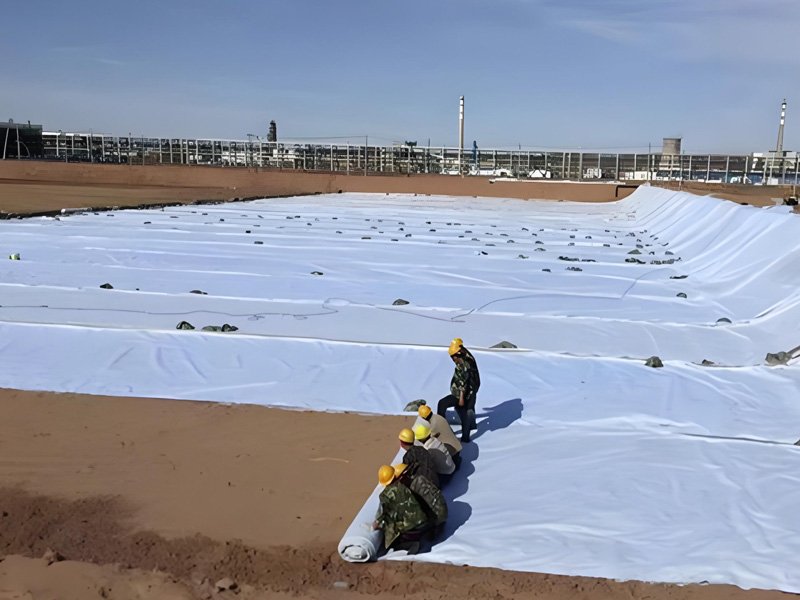
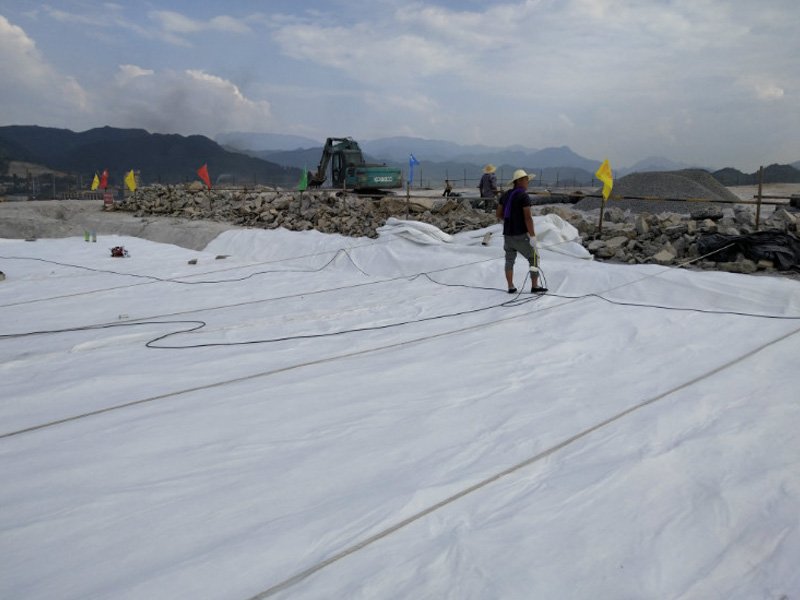
5. How to Choose the Right Non Woven Geotextile Fabric
Selecting the appropriate non woven geotextile depends on project requirements. Consider these factors:
- Drainage Needs: Choose lightweight fabrics (3–5 oz) for high-flow applications like French drains (150 gpm/ft²). Heavyweight fabrics (10–16 oz) suit erosion control with moderate drainage (80–100 gpm/ft²).
- Strength Requirements: For load-bearing projects like roads, select medium-weight (6–8 oz) or heavyweight fabrics with 200–425 lbs tensile strength.
- Environmental Conditions: Ensure UV resistance (70–90% strength retention) for exposed applications. Heavyweight fabrics resist 95% of chemical degradation in landfills.
- Budget: Lightweight fabrics are 50% cheaper ($0.20–$0.50/ft²) than heavyweight options ($1.00–$2.00/ft²). Balance cost with durability for 10–15% long-term savings.
- Installation: Use 12–18” overlaps and 6-inch staples every 1–2 feet to ensure 95% stability. Heavyweight fabrics require thicker aggregate (6–12”) for optimal performance.
Consult project engineers to match specifications (e.g., ASTM D4491 for flow rate) to local regulations, ensuring 100% compliance.
6. Conclusion
Non woven geotextile landscape fabric, with its high permeability (100–150 gpm/ft²), durability (80–425 lbs tensile strength), and versatility, is a cornerstone of modern landscaping and construction. From French drains to erosion control, its applications save 15–20% on maintenance costs and extend project lifespans by 20–30%. By understanding specifications, selecting the right weight (3–16 oz/yd²), and following proper installation, you can achieve 95% reliability in soil stabilization, filtration, and drainage. As the market grows at 6.8% annually, partnering with suppliers like BPM Geosythetics ensures access to high-quality fabrics tailored to your needs.

